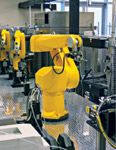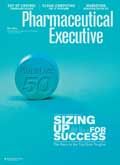On Tour with Merck's Robots
A factory tour to examine Merck's automated robots-and the human minds that inspire them
For reporters covering healthcare, a guided tour of Merck's R&D and manufacturing facilities is not unlike the visit a politician might give in a war zone: It's understood that the encounter is designed to reduce the potential for conflict through a better understanding of the interests that drive the relationship between the two parties. Faced with skeptical journalists, companies tend to stress ethical concerns and the quest for a better world, in preference to the financial incentives behind drug research. My visit to Merck was distinguished by an encounter with automated robots—and the human minds that inspire them. It was unclear which group costs more.

Merck's HTS robots move assay plates through the screening process.
At Merck's HTS lab, the tour's first stop, robots went about their business, screening cell-based assays mediated by transfected Chinese hamster ovary cells. Assays are screened in an attempt to discover active compound leads that could eventually yield new drug therapies. The robots' metal arms shifted 1,536-well and 3,456-well assay plates into and out of incubators, dye stations, and detectors. When one of the assays gets a hit, or glows florescent in response to a protein target, it's grouped with other hits over a period of three to six months, the time it takes to confirm a hit class of interest, explained Oleg Kornienko, automated systems team lead at the HTS lab.
Januvia (sitagliptin), a type 2 diabetes drug, was discovered in the HTS lab, reporters were told. At the time of the sitagliptin discovery, 8,000 compounds were available for screening, said Kornienko. That number has since grown to 3 million. Despite the vast efficiencies implicit in using these robots to screen such a rich diversity of targets, Kornienko would not say how much each of these nifty gadgets actually cost.
After the HTS lab, reporters were shepherded to the 400-acre West Point, Pennsylvania, manufacturing facility, where Tim Mallo, director of pharmaceutical manufacturing, explained that West Point's focus is primarily on Merck's oral products. Mallo is one of 8,500 workers on-site in West Point, where Gardasil and RotaTeq vaccines are also made. Reporters donned clean room gear for a portion of the tour, and gazed at machinery visible through doorway windows. Mallo said top-spray granulation machines let Merck turn out 2,700 tablets of Janumet—a combination of sitagliptin and metformin—every minute.
At the conclusion of the tour, Ann Weber, Merck's vice president, discovery and preclinical sciences, and Rahway chemistry head, recalled the heady days of the early 2000s, when she co-led the basic research team that discovered Januvia. Weber underscored the exponential growth of diabetes globally, and the urgency that creates for researchers working on new treatments. Asked about new compounds, and what kinds of therapies appear most promising in the fight against diabetes, Weber declined. "I can't tell you that," she said. A similar response might have been given to the question, "At what point can we pull troops out of Iraq or Afghanistan?" posed by a politician during a walk through Baghdad's Green Zone. The analogy is apt: Despite all the rhetoric about collaboration and partnership, it seems that industry competition around R&D—and the reluctance to spill commercial secrets—is still evaluated with the fervor of a military conflict.
Refine Your Pitch
So what's the point here? Most major pharmaceutical companies continue to offer guided research facility tours to reporters as a key vehicle in shaping their reputation. Such encounters are usually educational and informative. But like all enduring initiatives, the standard tour package can be improved. Suggestions from myself and other members of the fifth estate include the following: First, make sure scientists and technicians are prepped to handle reporters' questions upfront. The most important element here is to make your answers simple, accessible, and relevant to the big picture issue of how drug development relates to the interests of patients and society. Second, transparency is paramount. That requires a higher level of candor about the industry's cost profile; for example, basic questions about the price tag for building and maintaining a HTS lab, or questions about current pipeline compounds ought to be answered with specifics. As far as content for presentations goes, it should be future-oriented, with fresh data.
With the political winds blowing harder against the high cost of drugs, and as a few politicians actually "declare war" against the innovative companies that make them, it's in your ultimate interest to share what you know—and admit what you don't.

Is Artificial Intelligence a ‘Product’? Products Liability Implications for AI-Based Products
April 10th 2025As the physical products we use evolve to become increasingly complex, traditional products liability frameworks may not always fit to provide remedies for harm that can result from using novel product types.